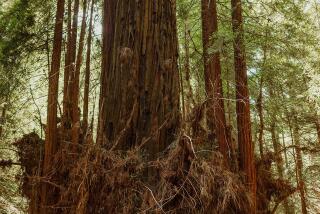Brazilian Tree Gets a Big Hug
- Share via
GLORIA DO GOITA, Brazil — They live a continent apart, but Ana Cristina Roldao and Yung Chin are transported to the same realms of rapture when they contemplate the stalwart trunk and spreading branches of the pernambuco tree.
Roldao, a conservationist, displays a maternal tenderness as she describes the beauty and dignity of the saplings in her care here in eastern Brazil. She caresses their bark, calls them “my daughters” and anxiously charts their growth.
For the record:
12:00 a.m. May 8, 2004 For The Record
Los Angeles Times Saturday May 08, 2004 Home Edition Main News Part A Page 2 National Desk 0 inches; 32 words Type of Material: Correction
Brazil map -- A map of Brazil with an article about the pernambuco tree in Friday’s Section A showed Rio de Janeiro in the wrong location. The correct location is shown above.
Chin too reveres the pernambuco. But he is inspired more by its potential for transformation into something else: an object of simple elegance, carved out of the tree’s rich red core and carefully whittled down to a slender, gently arced stick weighing barely 2 ounces.
“Wood is like drugs for us,” said the New York-based Chin, one of a few hundred craftsmen worldwide who hand-make bows for stringed instruments. “It’s a big turn-on when we see a nice board.”
For 200 years, nearly all violin, viola, cello and bass bows in the world have been fashioned from pernambuco wood, everything from the cruder sticks used by youngsters to saw Suzuki-method tunes out of their fiddles to the prized accessories of artists such as violinist Jascha Heifetz, who jealously guarded his favorite bow until his death. For professional bow-makers and serious string players, only pernambuco possesses the right qualities, the ideal blend of strength and flexibility, required in a top-flight bow.
But centuries of deforestation in the pernambuco’s native habitat have jeopardized not only the survival of Brazil’s national tree but the future of the bow-making industry -- and the enjoyment of musicians, orchestras and audiences around the world who depend on it.
In the coming months, the Brazilian government is expected to ask international authorities to slap restrictions, or even an outright ban, on trade in pernambuco wood. After years of hemming and hawing, officials appear poised finally to make a decision, spurred by the grim reality on the ground.
“They’re beginning to internalize the fact that there are hardly any trees left to manage,” Roldao said.
Roldao, 52, has devoted the last 20 years to saving the Caesalpinia echinata, which is confined to the coastal forest of eastern Brazil. Her lonely crusade has flung her into combat against ignorance, indifference and bureaucratic inertia, nemeses of environmental activists everywhere.
Yet not everything is as expected in this clash between ecology and industry, a battle being waged with increasing bitterness and hostility in so many other parts of the world.
Far from being implacable foes, conservationists such as Roldao and bow-makers such as Chin are finding themselves in surprising harmony. Their shared concern -- one for the survival of a national treasure, the other for the continuation of an Old World craft -- has united them on the urgent need to save the pernambuco tree and some of the ways to go about it.
They even agree on what advice to give to the Brazilian government as it considers endorsing an international embargo on pernambuco timber: Don’t do it.
Allow for at least limited trade, both Roldao and bow-makers argue, because that way the black market won’t shoot prices into the stratosphere -- a certain invitation to smuggling -- and landowners will have an incentive to reforest their properties with pernambuco trees. Otherwise, the tree will be left to dwindle steadily without the positive human intervention necessary to prevent it from vanishing.
“You need people to plant it,” Roldao said.
Enter Marco Raposo, a bow-maker in the southern state of Espirito Santo. Roldao regularly ships boxes full of thousands of pernambuco seeds to Raposo and other bow-makers in Brazil who have pledged to help the tree bounce back.
On his company’s estate, nearly 8,000 saplings stretch their limbs skyward. Their timber should be ripe for harvest in about 20 years, just when the 38-year-old Raposo will be approaching retirement.
Although Raposo intends to be around for that first culling, his goal is for the trees, their offspring and, consequently, his profession to outlast him.
“It’s about perpetuating, preserving craftsmanship,” he said.
Only a few decades ago, master bow-makers regarded the lack of apprentices as the biggest threat to their proud traditions. A modest revival of interest among younger people solved that problem -- today there are more than 200 professional bow-makers worldwide -- but in recent years, alarm among these individual artisans and among larger, mechanized bow-making companies has shifted to the diminishing supply of the raw material needed to ply their craft.
Many bow-makers acknowledge that they have been slow to recognize the danger presented by the rapid disappearance of pernambuco trees. Brazil’s 1997 prohibition on the clear-cutting of pernambuco didn’t merit much attention, since there seemed to be enough loopholes in the law and such lax enforcement that the wood continued to be available.
The bow-making community was shocked out of complacence by whispers in 1999 that the Convention on International Trade in Endangered Species of Wild Fauna and Flora, or CITES, might tighten or curtail the export and use of pernambuco, which would ring the death knell for bow-makers. Brazil must petition the international body by the end of the year if it wants to impose tougher restrictions on the pernambuco trade.
Adalberto Meira Filho, Brazil’s representative to CITES, said the government is still deliberating its recommendation.
No one disputes that the tree is becoming scarce. It’s impossible to say exactly how many survive, but ecologists note that the pernambuco’s natural habitat, the Atlantic rain forest, or Mata Atlantica, is a shadow of what it once was.
When Portuguese colonists landed on these shores 500 years ago, the Mata Atlantica was an abundant beard of green along the eastern coast, extending as far as 100 miles into the interior and sheltering millions of unknown species of plants and animals.
Centuries of land-clearing and commercial logging ensued. Huge swaths of trees were felled to make way for sugar-cane plantations and other cash crops -- a major contributor to continued deforestation.
Today, just 7% of the Mata Atlantica remains, stray clumps of vegetation strewn across South America’s largest country like so many scattered puzzle pieces.
The pernambuco suffered acutely, because colonists found that its heartwood produced a lovely deep-red dye suitable for the robes of the European aristocracy. Frenzied cutting and export fed a craze for the dye; indeed, the wood became so synonymous with the land of its origin that the tree’s designation in Portuguese, pau-brasil, gave the fledgling country its name.
Pernambuco gradually fell out of favor with the invention of synthetic dyes. But just as its use as a coloring agent was about to decline, a French artisan named Francois Xavier Tourte discovered that pernambuco was perfect for instrument bows, combining exactly the right properties of density, strength and elasticity.
By the time he died in 1835, Tourte had set standards for the bow -- weight, length, curve -- still largely adhered to today.
Nowadays, there is no organized use of pernambuco other than for carving bows. As much as 30 pounds of timber can be cut to provide a good-quality 2-pound board needed to make a single bow, according to the United Nations Environment Program. Tens of thousands of bows are produced each year.
Makers acknowledge wastefulness as a problem but say that more trees are lost to land-clearance in Brazil each year than to the demands of their craft. Still, they can’t imagine using anything other than pernambuco for their specialized creations, despite advances in the manufacture of carbon-graphite sticks.
For musicians, a top-class bow is often as important as their instruments. Although the hair on the bow touches the strings, it’s the stick itself that allows a performer such as Yo-Yo Ma to add color and nuance with different strokes of his arm. Press down hard on the strings for a deep-throated sound; bounce off for a lighthearted tone.
A decent modern bow can cost $500 to $5,000. Antique rarities by Tourte, 19th-century French master Dominique Peccatte or German artisan Nicholas Kittel can fetch as much as $100,000. “Just today, I paid 60,000 euros [about $72,000] for one bow by Peccatte. It bounces easily, and it produces a beautiful sound -- very silky,” said American violinist Charles Castleman, who owns about 75 bows. “The violin gives you the basic sound, but then what you do with it is with the bow.”
To help save the pernambuco -- and their livelihoods -- bow-makers such as Raposo and Chin helped form an international initiative in 2000 to plant seedlings and fund studies of the tree, which remains a mystery in many ways to scientists.
Another of the group’s partners is Roldao, whose one-woman National Pau-Brasil Foundation operates out of a whitewashed old schoolhouse here in Gloria do Goita, amid a lush landscape of low, rolling hills about an hour’s drive outside the port city of Recife.
A walking trail on the grounds informs visitors of the history of the pernambuco, while about 100,000 leafy little seedlings sit lined up in neat rows, in individual plastic sacks, waiting for new homes. Water for the trees comes from a well dug with money from the bow-makers group.
A small museum exhibits wood specimens, a photo of the pope planting a tree in the state of Espirito Santo and fading educational posters.
“At school, kids learn the history of the pau-brasil, but they never actually see one,” Roldao said.
The easiest places to encounter pernambuco these days are in the small number of of groves sown in and around Recife by Roldao’s father, who launched the Movement for the Defense of Pau-Brasil in 1970. He died eight years ago, bequeathing his consuming passion to Roldao, who had begun working with him in the ‘80s. She eventually left her job as an agriculture professor to dedicate herself full time to rescuing one of Brazil’s national symbols.
The trees her father planted are thriving, their branches forming luminous green canopies she ambles beneath. But none yet reach the towering proportions of the ancient pernambuco trees found by European colonists, some of which were 100 feet tall, with trunks so thick three men couldn’t wrap their arms around them.
One day, Roldao hopes, such leafy giants will be seen again.
“It’s my dream,” she said.











